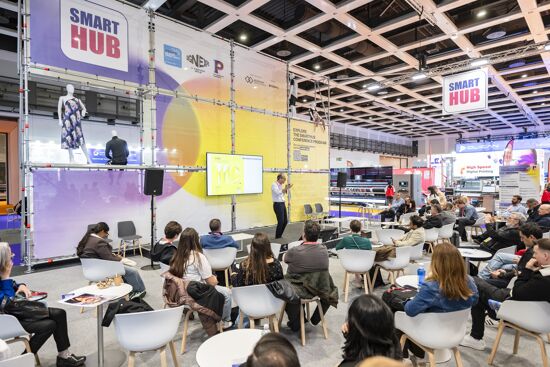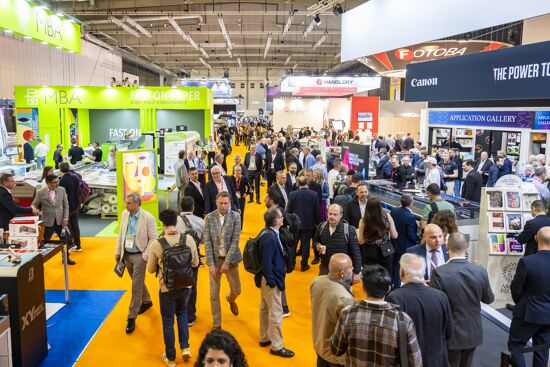A complex media, Guyenne’s Bluehide or Blue Back Paper, is a victim of its own success
Céline Procop, Guyenne’s CEO, reveres the company’s products as much as she does the men and women who make them [Sponsored Content]
Here Celine talks about one of the key products in the large format poster market, blue back paper. “Just like banners, blue back paper is one of the most sought after media for billboard applications and is therefore subject to fierce market competition, which has led to varying levels of quality.”
“Suitable for large-size outdoor applications, the blue back is a highly technical paper and belongs in the category of commodity papers. Offset printing machines have been replaced by solvent and UV printers, but it is fairly common to find blue back paper not treated for inkjet printing being printed with eco-solvent printers although these typically require a top coating for a standard rendering and optimal ink drying.”
In printing as in cooking, intended results can be affected by the choice of ingredients and recipe. “Anything can be printed! Even toilet paper!” says Céline Procop wryly. “With offset printing, the current rendering standards for some applications would not have been accepted”. Thus the market for Guyenne’s SuniSolvant range Bluehide paper is highly competitive and market share is fiercely fought for.
Gwennael Naud (pictured below) has been working at Guyenne for 15 years. Although a commercial agent by training, he soon became involved in the technical side of production.
Today, as a Production Coordinator, his opinion of the Bluehide is extremely favorable: “I love this product. Both the substrate and top coating are complex. It is a wet strength paper with 99.8% opacity. Its coating is slightly calendered and evenly smooth. It allows for rapid drying of even the most viscous inks, thus enhancing ink coverage performance to achieve higher yields.
For semi-industrial applications, ink drying times are essential. Today it is relatively simple to make Bluehide paper and yet it is far from being a basic type of paper.” Simple or complex? Gwennael Naud’s perspective on the production of the Bluehide speaks more generally to this extremely self-contradictory product. The product’s end use relies heavily on its technical qualities: after being soaked in glue for 24 hours, the printed paper is unfolded and then applied onto a 12 m2 support surface with sweeping strokes of the brush, and must preserve its color, print and technical qualities in outdoor conditions for days. This very challenging task is one that blue back paper manufacturers are required to meet on a daily basis.
There is a surprisingly wide range of quality grades for blue back papers on the market. The Bluehide is specifically designed for large-size applications and is suitable for printing with eco-solvent, mild-solvent and solvent inks. Step one consists in choosing a suitable substrate, which requires careful consideration. The coating process is then carried out on an off-line coating machine. It is a different technique from on-line coating which performs perfectly with offset and screen printers, but is not suitable for new eco-solvent and aqueous inkjet printers.
According to the company’s CEO, it is a pity that these features are all mixed up in an attempt to drag prices down and that the ordering customer is mostly forgotten. “What is the share of poster media, and in particular paper, in any global communication campaign?” Huge sums are typically allocated to secure the best creative or the most prestigious advertising spaces.
However, the wrong combination of machine, paper and ink will certainly produce a print performance that is well below the expectations of the client. We must be respectful of the quality of the work carried out ‘upstream’ in order to offer our clients the best quality poster paper. The reason why our Bluehide is priced 30% higher than an on-line coated blue back paper is because its quality grade is twice as good. Let us not forget that what comes first and foremost is the satisfaction of our consumers’ expectations”.
In Gwennael’s words, “the Bluehide is the best of the best of blue back papers”. He continues, “I love my job. There’s always a new challenge to look ahead and I love crafting solutions. For example, we treat various types of substrates, which is extremely challenging. The substrate and the coating are both equally important and we aim to achieve the perfect combination”. Gwennael’s comments echo the company’s plans to always improve its products. Next step for the Bluehide? Further reduce the ink drying time.
The company’s performance largely relies on the involvement of men like Gwennael Naud who are committed to maintaining and promoting high quality standards. The Bluehide is a fitting example of the difficulty that lies at the heart of a seemingly easy task. Surely this is how Masters are made, by repeating a task until one has achieved perfect mastery of it. Even though the Bluehide is part of a very competitive environment, Guyenne intends to set a benchmark for quality in a highly competitive market.
Asked what he and the Bluehide have in common, Gwennael answers with just a hint of humor: “My blue overalls of course and maybe a little bit of opacity! I am not very good at communication… I am aware that I could do better in that area. That’s why I feel kind of close to the Bluehide”.
Products and markets at Guyenne are as valued as the company’s personnel and are managed in a similar way, each must be of the best quality, can be combined with others to create a superior product and be an integral part in the company’s delivery of 100% perfect results. The company’s motto: making teamwork pleasurable.
C.W.
Topics
Interested in joining our community?
Enquire today about joining your local FESPA Association or FESPA Direct
Recent news

Industry Experts Explore the Evolution of Smart Manufacturing in the Textile Industry
A FESPA SmartHUB roundtable at Personalisation Experience 2025 discussed smart manufacturing's transformative impact on the textile industry. Experts highlighted the shift to on-demand customisation, driven by digital printing, data analytics, and automation. Key takeaways included enhanced machine control, significant waste reduction through intelligent software and colour management, and improved sustainability via energy efficiency and near-shoring, ensuring agility and environmental responsibility in textile production.

FESPA 2025 gathers leading visionaries from across the speciality print industry in Berlin
FESPA Global Print Expo 2025, European Sign Expo and Personalisation Experience (6 – 9 May 2025, Messe Berlin, Germany) welcomed Visionaries from across the speciality print industry to shape the future of print, develop forward-thinking business strategies, and explore innovative ways to translate emerging industry trends into tangible growth opportunities.

Exploring Cutting-Edge Textile Printing Innovation with Adobe Print Engine 7
Adobe PDF Print Engine 7, launched at FESPA Global Print 2025, significantly advances textile printing. Debbie McKeegan shares how it automates non-white substrate management and RGB colour handling, expands colour gamuts with in-RIP multicolour transparency blending, and streamlines workflows for efficiency and sustainability. This update boosts customisation, reduces waste, and positions businesses at the forefront of digital print innovation.

FESPA Global Print Expo 2025 - Overall Highlights
FESPA Global Print Expo, Europe's leading print and signage exhibition returned to Messe Berlin from 6 - 9 May 2025.